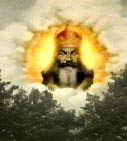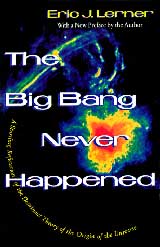HOME ~ @Com ~
On the 'Net since 1994The Universe as a Simulation...
The Grand Design
by Stephen Hawking
"It is not necessary to invoke
God to light the blue touch
paper and set the universe
going."Is the Universe an Alien's Simulation?
In the October 2010 issue of Scientific American magazine, the article 'The (Elusive) Theory of Everything' by Stephen Hawking and Leonard Mlodinow tells us that ”If aliens did enforce consistent laws, we would have no way to tell that another reality stood behind the simulated one”. I wonder.
If a simulation were to be made from some computing-entity, (digital or not) then its components will ultimately be information-bearing 'yes/no' answer-makers of questions: the bit.
If the bit is to be at the basis of such simulation, eventually a point will be reached, such as when trying to magnify the essence of the minutest thing or “particle” of which a universe is constructed. These alien inventors must then instruct their computing machines to “display” just any available random Schröder-particle from their bucket of finite parts! That might be an example of aliens using “consistent laws”.
This is exactly what is observed when particle smashers magnify things!
Hawking jokingly alluded to a similar situation in his A brief History of Time, by recounting of the remark of the old lady who exclaimed from the back of the room, “You're very clever, young man, very clever, but it’s turtles all the way down”. Perhaps it’s turtles all the way down; but if this can’t be, it has to stop somewhere.
That somewhere is where the alien simulators would have to resort to make the building blocks of the universe from like materials, entities which necessarily have exactly alike properties (and few of them) such as the attributes of charge, spin, etc., which we observe of elementary particles. Every electron, quark is indistinguishable from any other. In the simulated world it’s so in principle.
When a human observer of the extreme depths of reality demands the appearance of a particle-part -- because he is looking there -- the aliens’ simulation of the bottom is obliged to supply a random particle apparition, ex nihilo, made of just some of those parts.
That’s because that’s all there is at the ultimate depth. And the inquiry of the observer demands that something be presented by the alien’s design! It’s gotta be random because at that bottom level anything will do to “cause” of the thing can’t be caused further. In order to make everything work, the Quantum must not be causal must not make sense. 1
Whatever be the stuff of which everything is made, these supposed aliens created some small number of necessarily finite, simple rules, based on the counting numbers, of which stuff is made. (Unlike Scott Adams’ excellent treatment of this in his book God’s Debris, this turtle-bottom stuff, his God-dust particles, must have qualities or parameters which are disparate -- qualities such as charge or mass… else his God-dust particles would act to make for a very boring uneventful universe. It would be no fun if CP were inviolable or if the number zero or the number one behaved exactly like the other numbers! There must be a few exceptions to enable things to happen.
I am not one to put much credence in this sort of thing, but I think it cannot be discounted that we are simulated by perhaps other-leveled simulated aliens, ad infinitum, into the eons, dust on a policeman’s jacket in another something-verse.
So, the evidence may be in favor of alien simulation.
Perhaps it’s turtles all the way down. If this is so, then as an atheist, I find this appealing also. That’s because there is then no need of a First Cause.
With googolplexes of infinity available, isn’t it reasonable that somebody would have invented a simulation of parts to make a simple Big Bang?
Evidence that our universe is simulated
Mathematics' success at describing physical laws -
Why should mathematics be so successful in describing what we observe? This is not an question which can easily be answered in the context of a real physical universe. Why is, say, f=ma mostly true and why is E=mc2 so devilishly accurate?
Mathematics is based in the counting numbers, 1,2,3... (B. Russell & A. Whitehead; K. Gödel). So the reverse seems possible: to implement physical laws with numbers -- and by using the same parameters (or very nearly so) as those which we observe (M. J. Rees, Just Six Numbers, 1999; BOOK). An illustration of this is the fractal, Barnsley's fern, produced only by a recursive translation of the rectangle! If we lived in Sim City, everything would seem real.
Self-similarity -
Self-similarity, the hallmark of fractals is ubiquitous in the universe: water swirling down the drain is similar to a hurricane and to the structure of a galaxy.Waves: A water wave, an electromagnetic wave, a phonon, to an electron, etc. all have wave properties.
A Big Bang, viewed from the "outside", would seem to look very much like a black hole appears to us from inside of our universe (see L. Smolin's The Life of the Cosmos).
Electrons -
Elementary particles are all the same! Every electron in the universe is (only by definition) identical to every other. How can that be in real life? Nothing else in nature is like that. No identical twins, leaves and snow flakes, it is said, are exactly alike. Only elementary particles are so -- as if there were only one of each kind; as if only a pattern of for the particles exists -- a declaration of parameters. An idea.The self-similar "essence" of structure, of math-descriptive physics seems automatically to carry upwards, stating at the integer-based bottom level of the quantum.
Randomness -
Because a computing device which can simulate our universe must be finite (if it's not situated in an infinite someting-verse), it is necessary for the device to present something, on-the-fly, to observers, but only when they are observing. The fact that this seems to be so is the strongest evidence that we and everything else are simulations running on a sort of finite state machine. If our alien simulators had chosen to display nothing at all when we wish to magnify the Quantum, the game would have been over in Copenhagen in 1937 and we would have come to the bottom of this very clever deception nearly a century ago.2Desire -
Currently, astrophysicists who want to understand how things we know about work, frequently set out to simulate the actions of weather, of the climate, of galaxies, the internal dynamic life of stars, of dark matter and of high energy particle interactions. Once it's possible to simulate at Big Bang energies in detail, all that's needed will be the will to do so.Induction -
What can be said about a universe, a "place", outside of our own, in which we would only be a simulation? For one, it must be a bigger place in order to contain one or more devices which can simulate something which contains as much information as our universe. Because our reality feels real to us -- and if that's made only of information, of bits3 -- then of course it's only information that's need to make anything, including the putative alien simulators and their habitat.--Harald Illig Thursday, October 7, 2010
1 Perhaps time itself must also be similarly alien-simulated in digital fashion or in discrete chunks. It might then occur for us “spaced” in tiny packets or in some fractal or recursive arrangement or foam at the bottom of these aliens’ simulation.
2 Random noise in apparatus is similar to Quantum fluctuations. Everything in the universe affects everything else because forces and "fields" seem to have infinite range and can on occasion coincide, bunch up enough to be noticeable in our instruments. That's what may cause outliers in sensitive experiments, which cannot be explained by other means, or eliminated.
3 Entropy (information theory) - Wikipedia - LINK
Links:
Frog in Amber !
Precognition?
Are We Living in the Matrix?
The Standard model
Nag Hammadi Codex - On the Origin of the World
Peter Lynds: On a Finite Universe with no Beginning or End
Why do Americans still dislike Atheists?
Books about time
Math / Logic Library
For Dummies books
P R I M E R
Best treatment of time travel in a movie ever, period.
Grand Jury Prize at 2004 Sundance Film Festival An unexpected result in a process for traveling back several hours in time. The men initially use these rewind sessions to succeed in the stock market. But a dark consequence of their daily journeys eventually complicates matters. If this sounds like a very commercial, science fiction thriller, Primer is anything but that. The film has a tantalizing, sealed-in logic, akin to Memento, that forces viewers to see the fantastic with a certain dispassion. One may be tempted to sit through Primer again to more fully understand its paradoxes and ethical quandaries. --Tom Keogh
ev·i·dence –noun
1. that which tends to prove or disprove something; ground for belief.2. something that makes plain or clear; an indication or sign: His flushed look was visible evidence of his fever.
HOME ~ @Com ~
On the 'Net since 1994Is the Universe an Alien's Simulation? The Measurement Would Reveal
if The Universe is a Computer SimulationIf the cosmos is a numerical simulation, there ought to be clues in the spectrum of high energy cosmic rays, say theorists
The Grand Design
by Stephen Hawking
"It is not necessary to invoke
God to light the blue touch
paper and set the universe
going."
One of modern physics' most cherished ideas is quantum chromodynamics, the theory that describes the strong nuclear force, how it binds quarks and gluons into protons and neutrons, how these form nuclei that themselves interact. This is the universe at its most fundamental.
So an interesting pursuit is to simulate quantum chromodynamics on a computer to see what kind of complexity arises. The promise is that simulating physics on such a fundamental level is more or less equivalent to simulating the universe itself.
There are one or two challenges of course. The physics is mind-bogglingly complex and operates on a vanishingly small scale. So even using the world's most powerful supercomputers, physicists have only managed to simulate tiny corners of the cosmos just a few femtometers across. (A femtometer is 10^-15 meters.)
That may not sound like much but the significant point is that the simulation is essentially indistinguishable from the real thing, at least as far as we understand it.
It's not hard to imagine that Moore's Law-type progress will allow physicists to simulate significantly larger regions of space. A region just a few micrometers across could encapsulate the entire workings of a human cell.
Again, the behavior of this human cell would be indistinguishable from the real thing.
It's this kind of thinking that forces physicists to consider the possibility that our entire cosmos could be running on a vastly powerful computer. If so, is there any way we could ever know?Today, we get an answer of sorts from Silas Beane, at the University of Bonn in Germany, and a few pals. They say there is a way to see evidence that we are being simulated, at least in certain scenarios.
First, some background. The problem with all simulations is that the laws of physics, which appear continuous, have to be superimposed onto a discrete three dimensional lattice which advances in steps of time.
The question that Beane and co ask is whether the lattice spacing imposes any kind of limitation on the physical processes we see in the universe. They examine, in particular, high energy processes, which probe smaller regions of space as they get more energetic
What they find is interesting. They say that the lattice spacing imposes a fundamental limit on the energy that particles can have. That's because nothing can exist that is smaller than the lattice itself.
So if our cosmos is merely a simulation, there ought to be a cut off in the spectrum of high energy particles.
It turns out there is exactly this kind of cut off in the energy of cosmic ray particles, a limit known as the Greisen–Zatsepin–Kuzmin or GZK cut off.
This cut-off has been well studied and comes about because high energy particles interact with the cosmic microwave background and so lose energy as they travel long distances.But Beane and co calculate that the lattice spacing imposes some additional features on the spectrum. "The most striking feature...is that the angular distribution of the highest energy components would exhibit cubic symmetry in the rest frame of the lattice, deviating significantly from isotropy," they say.
In other words, the cosmic rays would travel preferentially along the axes of the lattice, so we wouldn't see them equally in all directions.
That's a measurement we could do now with current technology. Finding the effect would be equivalent to being able to to 'see' the orientation of lattice on which our universe is simulated.
That's cool, mind-blowing even. But the calculations by Beane and co are not without some important caveats. One problem is that the computer lattice may be constructed in an entirely different way to the one envisaged by these guys.
Another is that this effect is only measurable if the lattice cut off is the same as the GZK cut off. This occurs when the lattice spacing is about 10^-12 femtometers. If the spacing is significantly smaller than that, we'll see nothing.
Nevertheless, it's surely worth looking for, if only to rule out the possibility that we're part of a simulation of this particular kind but secretly in the hope that we'll find good evidence of our robotic overlords once and for all.
Source: arxiv.org/abs/1210.1847: Constraints on the Universe as a Numerical Simulationby Seth Lloyd
by Eric Drexler
Read it on-line: Engines of Creation Link: Completely FREE stuff
New directions in robots and automated manufacturing
Evolve Beyond Belief
Pick one up for a friend!
God's Debris pdf / txt
Ancestor 4Mb
The Gospel of Judas txt
A Universe With No Beginning or End The Limits of Science & the Science of Limits The KAMA SUTRA Wikipedia book sources
Search for sources given the ISBN number.Really free things, no strings.







